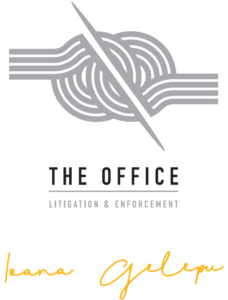Interview with: Ioana Gelepu, head of Ioana Gelepu The Office Litigation & Enforcement

Gelepu Ioana-Monica Law Office
What do you see as the main points that differentiate Gelepu Ioana-Monica Law Office from your competitors?
Ioana Gelepu Office Litigation & Enforcement promotes a formula that emphasizes Ioana’s personal involvement in nearly all the details of the mandates entrusted. I am the one who will lead each mandate through its specific path, from the macro vision (the determination of the course of action) to the micro details, such as the identification of the concrete arguments supporting the client’s position, being the author of putting each “brick” as a part of the construction and creation process of a case.
Which practices do you see growing in the next 12 months? What are the drivers behind that?
Ioana Gelepu The Office Litigation & Enforcement is a litigation boutique. The cases we handle are exclusively from the litigious or pre-litigious spectrum (meaning all types of situations where the seeds of discord have already been sown).
By itself, this is an area that is constantly being fueled (there were no years of litigation recession on the Romanian market).
The trend over the last 12 months (and prior to this timeframe) has been an increase of administrative and labor disputes. Regarding the first hypothesis, the explanation may derive from a certain slowness, on the one hand, and rigidity, on the other, of the reactions/positions of the public authorities. As for labor law, I believe the explanation comes from the fact that the whole economic background is becoming increasingly dynamic, and employers are becoming bolder in making various decisions with economic impact on the HR area.
What’s the main change you’ve made in the firm that will benefit clients?
Ioana Gelepu The Office Litigation & Enforcement has a light policy on costs. A key principle leading to this outcome, implemented with the aim of contributing to a lawyer-client relationship built on effective communication, is the non-quantification of those negligible, strictly indispensable services that can be qualified as purely administrative activities.
Is technology changing the way you interact with your clients, and the services you can provide them?
No until now. Given the field in which we operate (litigation), being attentive to the peculiarities of the case and addressing them creatively are essential tools for a fruitful outcome. As such, the whole relationship with the client is based on a highly personal approach, with the effect that we avoid any kind of patterns in our work.
In terms of modern types of client interaction (Zoom, Microsoft Teams, etc.), I can say that we use them in everyday interaction, hence they are perceived as the “new normal” in communication.
Can you give us a practical example of how you have helped a client to add value to their business?
We’re always vigilant about every twist and turn a dispute reaches. When discussing a pre-litigation project, the number of turns tends to increase, as the opposing party’s reactions to the client’s various proposals and positions are less predictable (or even unpredictable) than in a litigation situation (where the parties are constrained by procedural rules to make their arguments known from the outset). Within this specific context, the scenery of the dispute is likely to change from one day to the next. Precisely because we do not use universally valid prescriptions but try to enhance the client’s position by applying an adapted “treatment” from one day to the next, we have been able to avoid in some cases time-consuming and high-cost litigation by presenting to the client all the scenarios and their possible implications brought by a re-positioning of the opposite party during peace negotiations.
Briefly, we have been guided by a relentless attention to details, a seamless involvement to lead the case towards the most prudent course, but also by a frank dialogue, so that the client can have realistic expectations about the case and be able to take the wisest decisions from a business angle, which in some cases means precisely avoiding a litigation.
Are clients looking for stability and strategic direction from their law firms – where do you see the firm in three years’ time?
As explained above, the signature feature of Ioana Gelepu The Office Litigation & Enforcement is that almost all the details of the projects are managed by me, being directly involved in each mandate, with all that this very particular approach entails. Therefore, we aim for a careful selection of the mandates, with a caseload not exceeding 100 files and a team of maximum 3-4 lawyers.